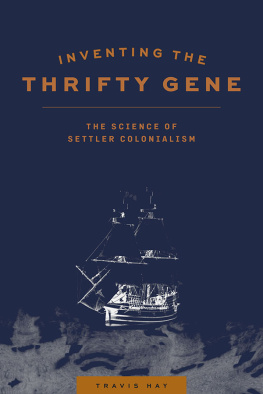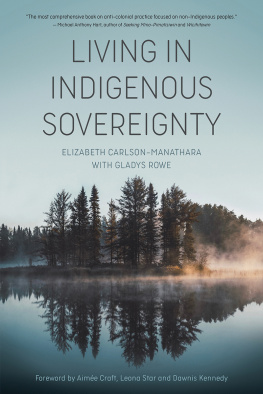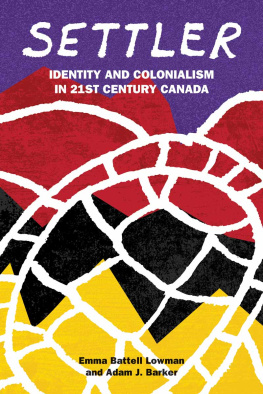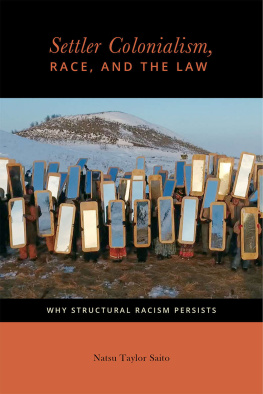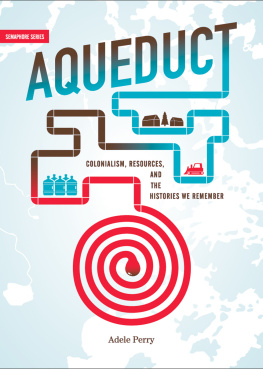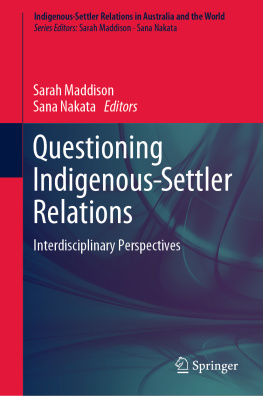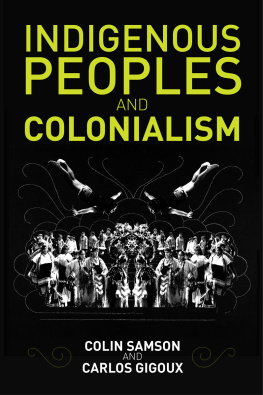
Inventing the
Thrifty Gene
The Science of Settler Colonialism
Travis Hay
With an Afterword by Teri Redsky Fiddler
Inventing the Thrifty Gene: The Science of Settler Colonialism
Travis Hay 2021
Afterword Teri Redsky Fiddler 2021
25 24 23 22 21 1 2 3 4 5
All rights reserved. No part of this publication may be reproduced or transmitted in any form or by any means, or stored in a database and retrieval system in Canada, without the prior written permission of the publisher, or, in the case of photocopying or any other reprographic copying, a licence from Access Copyright, www.accesscopyright.ca, 1-800-893-5777.
University of Manitoba Press
Winnipeg, Manitoba, Canada
Treaty 1 Territory
uofmpress.ca
Cataloguing data available from Library and Archives Canada
ISBN 978-0-88755-934-1 (paper)
ISBN 978-0-88755-938-9 (pdf)
ISBN 978-0-88755-936-5 (epub)
ISBN 978-0-88755-940-2 (bound)
Cover image by Lak Williams
Cover and interior design by Jess Koroscil
Printed in Canada
The University of Manitoba Press acknowledges the financial support for its publication program provided by the Government of Canada through the Canada Book Fund, the Canada Council for the Arts, the Manitoba Department of Sport, Culture, and Heritage, the Manitoba Arts Council, and the Manitoba Book Publishing Tax Credit.
Dedicated to the memory of Josias Fiddler (19492012)
There is no power relation without the correlative constitution of a field of knowledge, nor any knowledge that does not presuppose and constitute at the same time power relations.
Michel Foucault, Discipline and Punish
Contents
- Introduction
Underserviced and Overstudied - Chapter One
On the Origins of Thrifty Genes - Chapter Two
The Operation of Being Civilized - Chapter Three
Studied to Death - Chapter Four
The Marrow Thief - Chapter Five
Chief Josias Fiddler - Chapter Six
The Return of the Thrifty Gene - Conclusion
The Grandfather Rocks of Josias Fiddler - Afterword
Josias Fiddlers Life and Legacy
By Teri Redsky Fiddler
Introduction
Underserviced and Overstudied
First Nations communities in northwestern Ontario have historically lacked access to health care, clean water, affordable food, and safe housing. At the same time, these communities have never lacked access to well-funded Canadian scientists who have travelled north to perform invasive acts of medical inquiry. All too often these productions of scientific knowledge and public health data have been interpreted and assembled in ways that obscure the operation of settler colonial power on Indigenous bodies and erase the violence of federal Indian policy (or the laws, standards, and practices associated with the Canadian governments attempts to govern First Nations, Mtis, and Inuit peoples). In this book, I refer to this long-standing historical process as the science of settler colonialism.
The science of settler colonialism is a three-step process: first, Indigenous peoples are subjected to the relocating, malnourishing, and traumatizing impacts of federal Indian policy; second, settlers are sent on research trips to observe and gather data on the impacts of this intervention; and third, these data are interpreted and assembled in ways that blame Indigenous peoples for their own poor health outcomes. My primary example of the historical elaboration of this concept will be the thrifty gene hypothesis, which proposed that Indigenous bodies were genetically predisposed to diabetes, obesity, and other metabolic syndromes because of the foodways of their ancestors. The hypothesis was invented in 1962 by the pioneer of primitive population genetics James V. Neel, who wrongly assumed that Indigenous peoples lacked agriculture and were unable to secure a steady food supply prior to colonial contact with European civilizations. A thrifty gene, Neel proposed, might emerge in hunter-gatherers as a response to the evolutionary selection pressure of living a feast-and-famine lifestyle in which eating typically takes place in acute and accelerated periods (i.e., after a successful hunt). Ultimately, Neel was unable to find a thrifty gene, though not for lack of searching. Throughout the 1960s, he travelled through the rainforests of Brazil and Venezuela seeking remote Indigenous populations in whose blood, urine, saliva, breast milk, and bone marrow he searched for ancient answers about the origin and fate of humans. Unsuccessful in his hunt for the thrifty gene, Neel laid the hypothesis to rest in the rainforests of the Amazon.
But the idea of a thrifty gene persisted. In the 1990s, the hypothesis became the basis for a major Canadian research project undertaken in Sandy Lake First Nation. Located in the far northwest of Ontario, Sandy Lake First Nation is an Anishinaabe
As I hope readers are aware, there is no such thing as a thrifty gene. Like Neel before them, the Canadian scientists involved in the study eventually revised and withdrew their findings related to thrifty genes in Sandy Lake. And, though I will unpack the contents of the hypothesis and its precise shortcomings, my objectives in this book do not lie in the realm of debunking. Instead, I offer a historical analysis of how Anishinaabe blood became a thing of supreme scientific value to settlers. In other words, Canadian scientists have assisted in the sanitizing of state policies and the whitewashing of settler colonial history. By providing evidence of the long history of human experiments, malnutrition studies, vaccine trials, and gene-hunting studies that led to the rise and reinvention of the thrifty gene, I diagnose settler colonial science as a symptom of Canadians genocidal way of relating to and thinking about Indigenous peoples.
Such a story has to be told carefully and with respect. These are histories that can be painful to read and doubly so for Indigenous readers, who will find in these pages an all too familiar story. Conversely, Canadian readers who are unaware that their country has wilfully and knowingly participated in the biological (not merely cultural) genocide of Indigenous peoples might find in these pages a Canada that they do not recognize. It is challenging to write for these two audiences simultaneously. Certainly, many Indigenous peoples already know from their experience what it has taken me roughly a decade to prove through archival research. Of course, some might not. However, as a non-Indigenous historian from northwestern Ontario who seeks to catalogue research crimes and prove to my fellow Canadians the genocidal realities of the lands that we occupy as settlers, I have not held back in my deployment of evidence and example. For this reason, I begin with a preview of the contents of the book and a breakdown of its chapters before dealing with definitions of thrifty genes, settler colonialism, and other terms that ought not to be taken for granted. Throughout the book, I provide comprehensive chapter breakdowns so that discussions of genocide and violence against children do not break into the text without considerable warning. My hope is that this organizational structure will provide ample evidence to Canadian readers while flagging areas of the text that might be especially painful for Indigenous readers.
Chapter Overview
Because Canadian federal Indian policy and settler colonial science emerged out of British imperialism and Victorian racial science, I begin in Chapter 1 with a focus on Charles Darwin and his writings on Indigenous peoples. Darwin is an originator of the thrifty gene hypothesis as well as the science of settler colonialism in the sense that he first articulated the cultivation of land as something that would beget the disappearance of the Indian. In writing of the Indian in this way, I refer not to the reality of Indigenous peoples (or peoples from India) but to the mythic and essential construction of Indianness as produced by travelling white male scientists who saw in Indigenous peoples a disappearing race.
Next page
